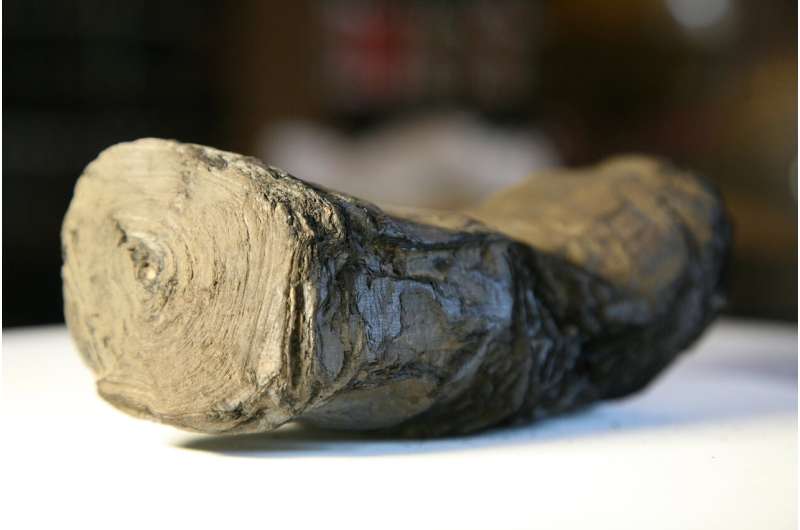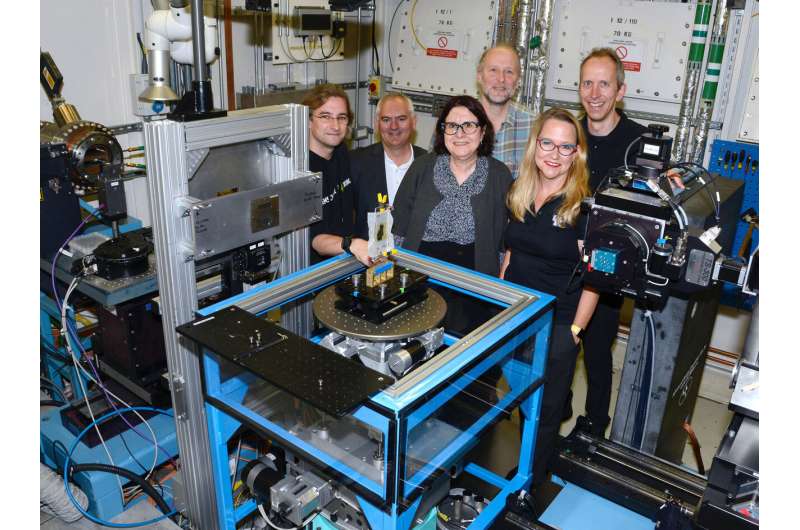Team studies 2000-year-old Herculaneum Scrolls

Researchers led by the renowned ancient artifacts expert Professor Brent Seales will be using the U.K."s Diamond Light Source synchrotron science facility in the heart of Oxfordshire to examine a collection of world-famous ancient artifacts owned by the Institut de France. Using this powerful light source and special techniques the team has developed, the researchers are working to virtually unwrap two complete scrolls and four fragments of damaged Herculaneum scrolls. After decades of effort, Seales thinks the scans from Diamond represent his team's best chance to reveal the contents of these 2,000-year-old papyri.
Prof Seales is director of the Digital Restoration Initiative at the University of Kentucky (U.S.), a research program dedicated to the development of software tools that enable the recovery of fragile, unreadable texts. Seales says, "Diamond Light Source is an absolutely crucial element in our long-term plan to reveal the writing from damaged materials, as it offers unparalleled brightness and control for the images we can create, plus access to a brain trust of scientists who understand our challenges and are eager to help us succeed. Texts from the ancient world are rare and precious, and they simply cannot be revealed through any other process. Thanks to the opportunity to study the scrolls at Diamond Light Source, which has been made possible by the National Endowment for the Humanities and the Andrew Mellon Foundation, we are poised to take a tremendous step forward in our ability to read and visualize this material. The scan session promises to be a key moment in our quest for a reliable pathway to reading the invisible library."
Over the past two decades, Prof Seales and his team have digitally restored and read a vast amount of material in the "invisible library" of irreparably damaged manuscripts. In 2015, they achieved singular success when they visualized the writing inside five complete wraps of an ancient Hebrew scroll from En Gedi. For the first time ever, a complete text from an object so severely damaged that it could never be opened physically was digitally retrieved and recreated, representing a true technical breakthrough. It is this technology that Seales' team plans to deploy on the data collected at Diamond.
A long-term goal of Prof Seales has been to reveal the contents of the most iconic items in the invisible library, the Herculaneum scrolls. Buried and carbonized by the deadly eruption of Mount Vesuvius in 79 AD, the scrolls are too fragile to be opened and represent the perfect storm of important content, massive damage, extreme fragility, and difficult-to-detect ink.

These famous papyri were discovered in 1752 in an ancient Roman villa near the Bay of Naples believed to belong to the family of Julius Caesar. As such, they represent the only surviving library from antiquity. The majority of the 1,800 scrolls reside at the Biblioteca Nazionale di Napoli, although a few were offered as gifts to dignitaries by the King of Naples and wound up at the Bodleian Library at Oxford University, the British Library and the Institut de France.
Last May, Prof Seales headed a small team of undergraduate students in Paris to survey the Institut de France's Herculaneum collection. They examined two completely intact scrolls, along with four small fragments from scrolls unrolled in the late 1800s. All six items will be scanned at Diamond. Because the four fragments contain many layers and feature visible, exposed writing on the top, they will provide the key data needed to develop the next iteration of the team's "virtual unwrapping" software pipeline, a machine-learning algorithm that will enable the visualization of carbon ink.
The use of carbon ink is one of the main reasons these scrolls have evaded deciphering, according to Prof Seales. Unlike metal-based inks, such as the iron gall used to write medieval documents, carbon ink has a density similar to that of the carbonized papyrus on which it sits. Therefore, it appears invisible in X-ray scans.
"We do not expect to immediately see the text from the upcoming scans, but they will provide the crucial building blocks for enabling that visualization. First, we will immediately see the internal structure of the scrolls in more definition than has ever been possible, and we need that level of detail to ferret out the highly compressed layers on which the text sits. In addition, we believe strongly—and contrary to conventional wisdom—that tomography does, indeed, capture subtle, non-density-based evidence of ink, even when it is invisible to the naked eye in the scan data. The machine-learning tool we are developing will amplify that ink signal by training a computer algorithm to recognize it pixel-by-pixel from photographs of opened fragments that show exactly where the ink is, voxel-by-voxel, in the corresponding tomographic data of the fragments. The tool can then be deployed on data from the still-rolled scrolls, identify the hidden ink, and make it more prominently visible to any reader."
The scanning of these delicate items at the Diamond Light Source will be a mammoth undertaking for all involved. Because of their extreme fragility, the Seales team fabricated custom-fit cases for the scrolls that enable as little handling as possible. Only highly trained conservators are allowed to handle the samples. The Director of the Bibliothèque at the Institut de France, Mme Françoise Bérard will personally pack the scrolls into their special cases for travel to the U.K., and after arrival, they will be inserted into the I12 beamline at Diamond. The I12 beamline or JEEP (Joint Engineering, Environmental, and Processing) beamline is a high-energy X-ray beamline for imaging, diffraction and scattering, which operates at photon energies of 53-150 keV.
While a handful of the scrolls from Herculaneum have been subjected to physical (and largely disastrous) efforts to open them, no one as yet has managed to reveal complete texts from the hundreds that remain tightly closed. Principle beamline scientist on the Diamond I12 Beamline, Dr. Thomas Connolley, says, "This is the first time an intact scroll has been scanned in such detail at Diamond Light Source. We are very excited to work with the research team, playing our part in what we hope will be a major step forward in unlocking the secrets that the scrolls contain."
Seales says, "It's ironic, and somewhat poetic, that the scrolls sacrificed during the past era of disastrous physical methods will serve as the key to retrieving the text from those that survive but are unreadable. And by digitally restoring and reading these texts, which are arguably the most challenging and prestigious to decipher, we will forge a pathway for revealing any type of ink on any type of substrate in any type of damaged cultural artefact."
The research team will be at Diamond to scan the scrolls for several days at the end of September.
More information: A. Tournié el al., "Ancient Greek text concealed on the back of unrolled papyrus revealed through shortwave-infrared hyperspectral imaging," Science Advances (2019). advances.sciencemag.org/content/5/10/eaav8936
Journal information: Science Advances
Provided by Diamond Light Source




















